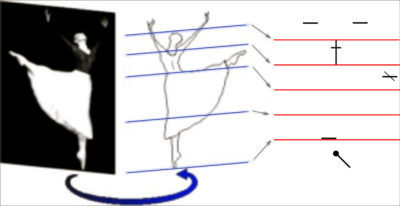About BMN
What is Benesh Movement Notation?
Modified from: Benesh International
Benesh Movement Notation (BMN) was devised by Rudolf and Joan Benesh and first published in 1956. It is a concise, accurate and versatile written system for recording human movement.
BMN is most widely used in the recording and restaging of dance works, where it has proved invaluable, both as a day-to-day tool in the rehearsal studio, and as a means of preserving our dance heritage.
Benesh Movement Notation is a universal language that provides:
- a three dimensional representation of movement including precise indication of the whereabouts of people and their relationship to one another within the working space, the directions in which they face and their paths of travel, and the movement and positions of the limbs, head, hands, feet and body
- a tool for the analysis of movement, rhythm and phrasing and the structure of dance works
- the opportunity to accurately record choreography without having to rely on video
- the ability to teach students repertoire from world-class dance companies using more than 250 Benesh scores that are available for educational purposes
Click to learn ![]() How BMN Works.
How BMN Works.
